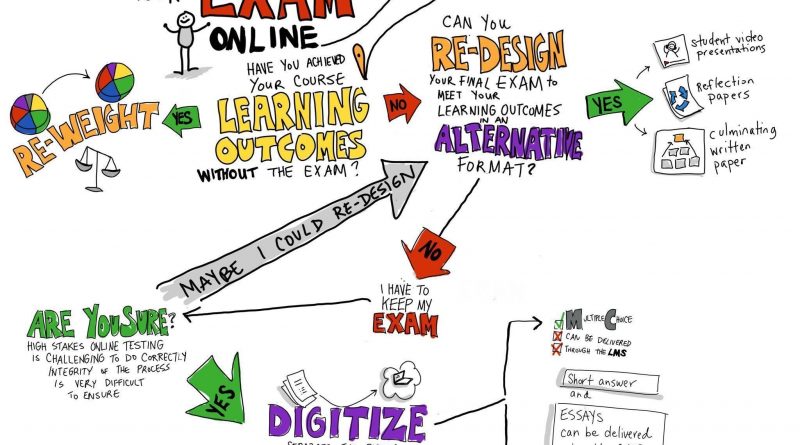Alternatives to Exams
Image: Online Assessments Flow Chart by Giulia Forsythe, Associate Director Center for Pedagogical Innovation, Brock University
There are many viable alternatives to traditional exams when assessing your students. Finding a good assessment strategy requires (re)determining what you want your students to learn, and thinking holistically about your plan for assessment and how you will assign grades. You can leverage the online learning environment for its opportunities for collaborating with peers, sharing multiple forms of media, and making use of interactive tools. Before deciding to maintain a traditional exam, it may be useful to think broadly about the kinds of assessments that might engage students. Below is a collection of suggestions to get you thinking.
- Discussions – Online discussions can serve as a graded assessment if you pose a specific, open-ended prompt and evaluate students’ (potentially collaborative) contributions to the conversation. Students can share and respond to each others ideas with text, images, and videos. These can unfold asynchronously (over time) through Canvas’s threaded discussion boards or videos created in Voice Thread. Alternatively, using tools such as Webex or Zoom these discussions can happen synchronously (in real time). Regardless of how you format the discussion, it is critical to provide students with clarity as to how their participation will be converted into a grade. See example online discussion rubrics from the University of Central Florida.
- Student Created Videos – Students can present their ideas during online course meetings by sharing their screens / videos for presentations, or asynchronously by creating videos to demonstrate their learning. See how University of Sydney faculty are using video assignments.
- Simulations and Labs – Provide students with opportunities to engage with real-world data or use simulations of laboratory environments. These are useful for practicing skills of the discipline and for engaging in real-world problems. See suggestions for hosting remote labs from Harvard.
- Group Projects – Online collaborations allow ideas to be tested and evaluated by peers and experts alike. Encourage student collaboration with the same online tools you use to teach the course. Groups can be created in Canvas, and assignments, or discussions, can be assigned to a group. Encourage or assign groups to meet regularly via Zoom. See this article on group projects from Inside Higher Ed.
- Peer Review – Feedback from peers can motivate students to learn from each other, which can be important in larger classes. Guide students to give each other valuable feedback using rubrics or other prompts. You can demonstrate to students how to provide productive feedback by modeling it yourself, and prompting them to ask each other guiding questions.
- ePortfolios – ePortfolios allow you to collect evidence of learning, including students’ reflections, making student learning over time visible. Having students regularly reflect on their own learning also promotes constructive habits of mind. This article suggests technologies at Tufts for creating ePortfolios.
- Blogs – Blogs can allow students to communicate their ideas in a more extended format than a discussion board while still supporting interactions between students (see Vanderbilt’s guide for writing blog posts).
- Papers or Research Reports – Longer-format writing can engage students with complex tools or tasks common within a disciplinary context and can include real-world problem solving. Writing research reports can encourage students to synthesize key ideas in a course, and papers can prompt students to reflect on what they’ve taken away from the course. Consider providing examples of expert performance, rubrics, and other structures that enable students to assess their own work. Building in milestones or checkpoints will also help support students to successfully complete this type of assignment.
- Creative Projects – Creative projects can encourage students to demonstrate their learning by creating maps, photo essays, journaling about field work or engaging in “wicked problems,” i.e., problems that have changing parameters, are resistant to solutions, involve incomplete data, or are difficult to recognize (P Hanstedt, Creating wicked students: Designing courses for a complex world). Some examples of wicked problems in different disciplines include:
- Biology: Create an informational pamphlet on an emerging infectious disease, pitched to parents of small children. Include causative agent and vector, threat to local population, and possible measures to reduce risk.
- Nutrition: The government of New York State is developing a list of recommendations regarding the lifestyles of primary-school age children. Choose a particular region of the state and develop an appropriate menu for breakfast, providing a carefully researched rationale that takes into consideration BOTH nutritional and cultural factors.
- Poetry: The medical school faculty is revising its curriculum. Provide a rationale for the inclusion of a literature course in this curriculum, citing and carefully analyzing three particular poems.
- Games & Interactive Competitions – Assessments can also be fun.
While moving your course online can be challenging, creative assessments can help create a sense of community between learners and teachers. If you are considering different kinds of assessments, consider proposing several options to the class. Letting students indicate their preferences can help them feel more empowered and engaged in the course. Remember that whatever form of assessment you decide to use, be sure to clearly communicate how will be different in an online format, what students can do to prepare, and where they can go to ask questions or get help.
Keep in mind there are no perfect solutions, especially in a situation where you are transferring a course online mid-stream. If you ultimately decide that the best way to achieve your intended goals for student learning is via a traditional exam, see Adapting Exams to Teach Remotely and Keep Teaching from Tufts ETS.
See Also
- Experiences of Tufts Faculty with online assessments
- Adapting Exams to Teaching Remotely
- Remote Teaching at Tufts in Response to the Health Crisis
- Grading
- Revising Assignments for Remote Teaching (Harvard Bok Center)




